Strategic Management and Leadership Skills Report - BTEC
VerifiedAdded on 2022/08/30
|11
|3519
|23
Report
AI Summary
This report delves into the intricate relationship between strategic management and leadership, examining the impact of various leadership styles on strategic decisions. It explores leadership theories such as trait, behavioral, and situational theories, and leadership styles including democratic, autocratic, and transformational approaches. The report analyzes how these styles influence organizational strategy, especially in the context of Industry Revolution 4.0, and provides a personal reflection on the most suitable leadership style in this digital era. It further outlines a personal development plan, focusing on the skills required for effective leadership in the future, including strong communication, innovation, and technological proficiency, and suggests strategies for organizational development and talent acquisition to support strategic goals.
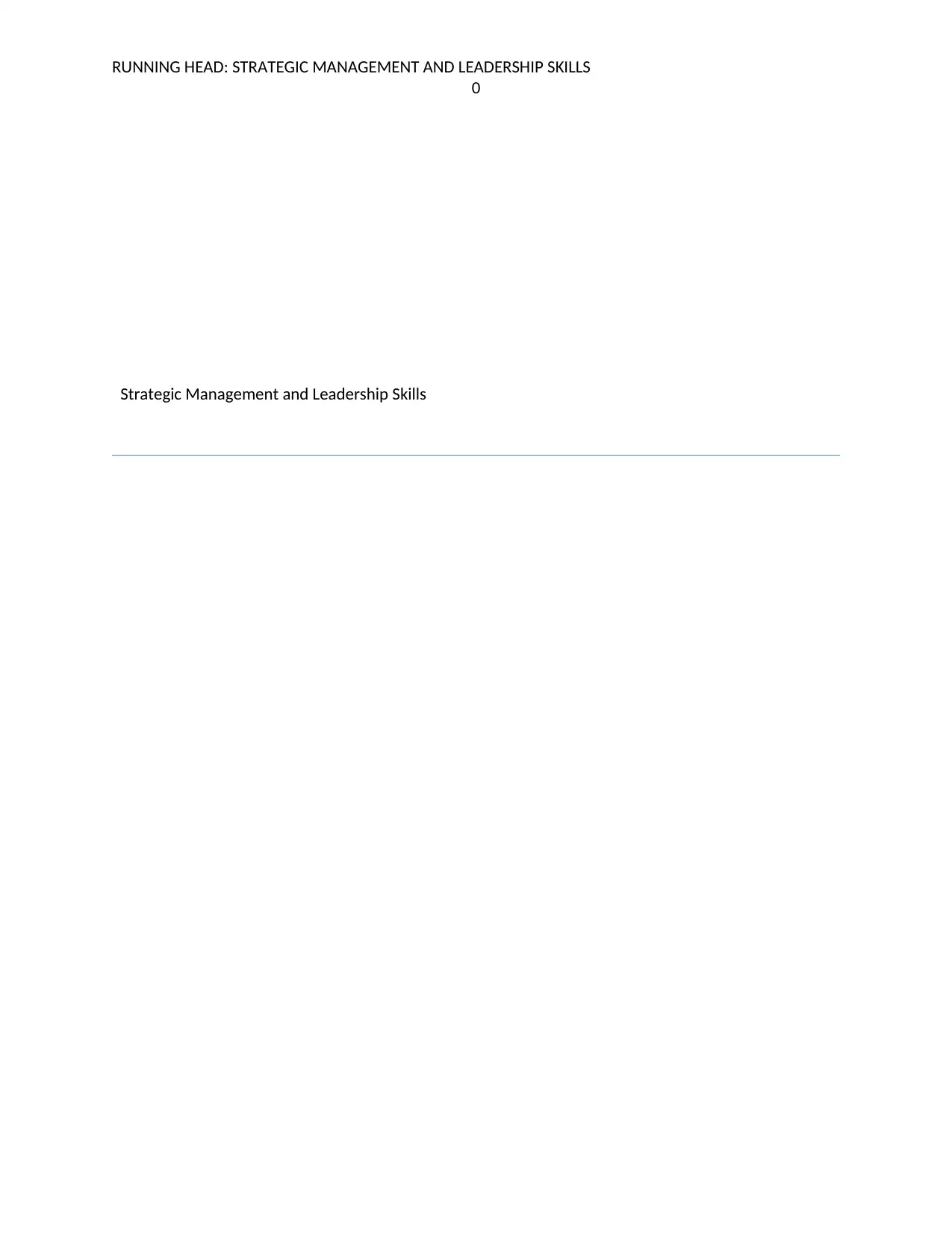
RUNNING HEAD: STRATEGIC MANAGEMENT AND LEADERSHIP SKILLS
0
Strategic Management and Leadership Skills
0
Strategic Management and Leadership Skills
Paraphrase This Document
Need a fresh take? Get an instant paraphrase of this document with our AI Paraphraser
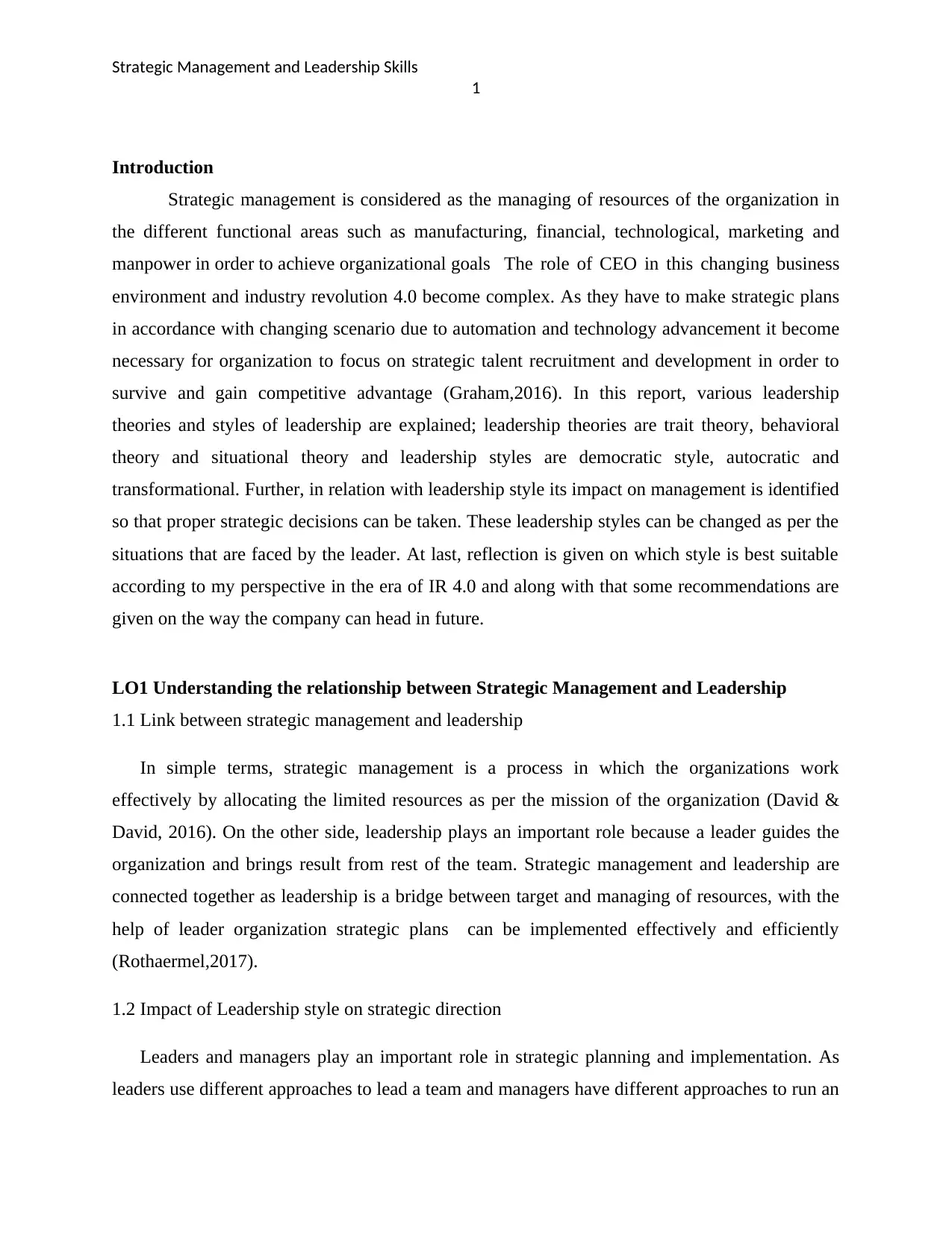
Strategic Management and Leadership Skills
1
Introduction
Strategic management is considered as the managing of resources of the organization in
the different functional areas such as manufacturing, financial, technological, marketing and
manpower in order to achieve organizational goals The role of CEO in this changing business
environment and industry revolution 4.0 become complex. As they have to make strategic plans
in accordance with changing scenario due to automation and technology advancement it become
necessary for organization to focus on strategic talent recruitment and development in order to
survive and gain competitive advantage (Graham,2016). In this report, various leadership
theories and styles of leadership are explained; leadership theories are trait theory, behavioral
theory and situational theory and leadership styles are democratic style, autocratic and
transformational. Further, in relation with leadership style its impact on management is identified
so that proper strategic decisions can be taken. These leadership styles can be changed as per the
situations that are faced by the leader. At last, reflection is given on which style is best suitable
according to my perspective in the era of IR 4.0 and along with that some recommendations are
given on the way the company can head in future.
LO1 Understanding the relationship between Strategic Management and Leadership
1.1 Link between strategic management and leadership
In simple terms, strategic management is a process in which the organizations work
effectively by allocating the limited resources as per the mission of the organization (David &
David, 2016). On the other side, leadership plays an important role because a leader guides the
organization and brings result from rest of the team. Strategic management and leadership are
connected together as leadership is a bridge between target and managing of resources, with the
help of leader organization strategic plans can be implemented effectively and efficiently
(Rothaermel,2017).
1.2 Impact of Leadership style on strategic direction
Leaders and managers play an important role in strategic planning and implementation. As
leaders use different approaches to lead a team and managers have different approaches to run an
1
Introduction
Strategic management is considered as the managing of resources of the organization in
the different functional areas such as manufacturing, financial, technological, marketing and
manpower in order to achieve organizational goals The role of CEO in this changing business
environment and industry revolution 4.0 become complex. As they have to make strategic plans
in accordance with changing scenario due to automation and technology advancement it become
necessary for organization to focus on strategic talent recruitment and development in order to
survive and gain competitive advantage (Graham,2016). In this report, various leadership
theories and styles of leadership are explained; leadership theories are trait theory, behavioral
theory and situational theory and leadership styles are democratic style, autocratic and
transformational. Further, in relation with leadership style its impact on management is identified
so that proper strategic decisions can be taken. These leadership styles can be changed as per the
situations that are faced by the leader. At last, reflection is given on which style is best suitable
according to my perspective in the era of IR 4.0 and along with that some recommendations are
given on the way the company can head in future.
LO1 Understanding the relationship between Strategic Management and Leadership
1.1 Link between strategic management and leadership
In simple terms, strategic management is a process in which the organizations work
effectively by allocating the limited resources as per the mission of the organization (David &
David, 2016). On the other side, leadership plays an important role because a leader guides the
organization and brings result from rest of the team. Strategic management and leadership are
connected together as leadership is a bridge between target and managing of resources, with the
help of leader organization strategic plans can be implemented effectively and efficiently
(Rothaermel,2017).
1.2 Impact of Leadership style on strategic direction
Leaders and managers play an important role in strategic planning and implementation. As
leaders use different approaches to lead a team and managers have different approaches to run an
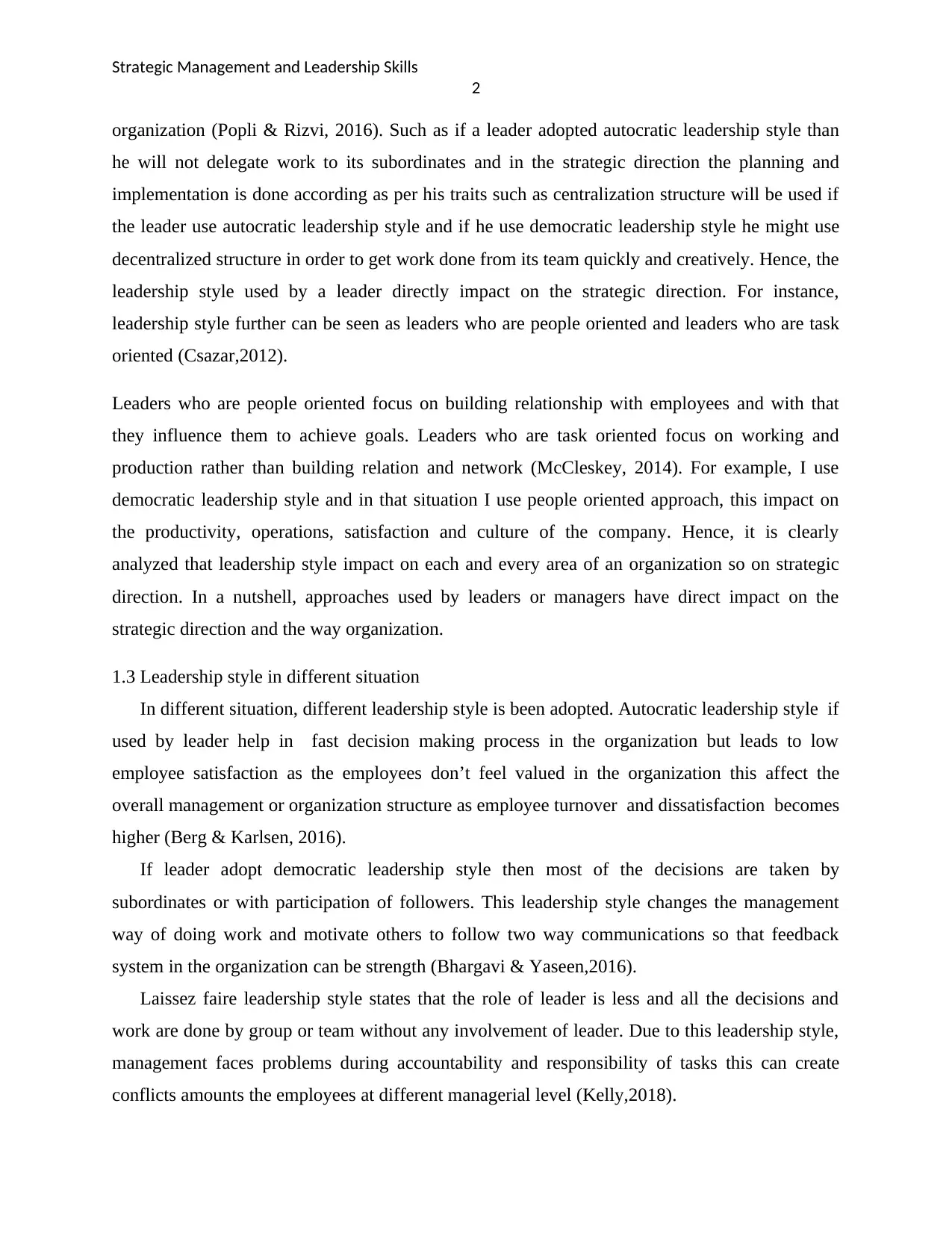
Strategic Management and Leadership Skills
2
organization (Popli & Rizvi, 2016). Such as if a leader adopted autocratic leadership style than
he will not delegate work to its subordinates and in the strategic direction the planning and
implementation is done according as per his traits such as centralization structure will be used if
the leader use autocratic leadership style and if he use democratic leadership style he might use
decentralized structure in order to get work done from its team quickly and creatively. Hence, the
leadership style used by a leader directly impact on the strategic direction. For instance,
leadership style further can be seen as leaders who are people oriented and leaders who are task
oriented (Csazar,2012).
Leaders who are people oriented focus on building relationship with employees and with that
they influence them to achieve goals. Leaders who are task oriented focus on working and
production rather than building relation and network (McCleskey, 2014). For example, I use
democratic leadership style and in that situation I use people oriented approach, this impact on
the productivity, operations, satisfaction and culture of the company. Hence, it is clearly
analyzed that leadership style impact on each and every area of an organization so on strategic
direction. In a nutshell, approaches used by leaders or managers have direct impact on the
strategic direction and the way organization.
1.3 Leadership style in different situation
In different situation, different leadership style is been adopted. Autocratic leadership style if
used by leader help in fast decision making process in the organization but leads to low
employee satisfaction as the employees don’t feel valued in the organization this affect the
overall management or organization structure as employee turnover and dissatisfaction becomes
higher (Berg & Karlsen, 2016).
If leader adopt democratic leadership style then most of the decisions are taken by
subordinates or with participation of followers. This leadership style changes the management
way of doing work and motivate others to follow two way communications so that feedback
system in the organization can be strength (Bhargavi & Yaseen,2016).
Laissez faire leadership style states that the role of leader is less and all the decisions and
work are done by group or team without any involvement of leader. Due to this leadership style,
management faces problems during accountability and responsibility of tasks this can create
conflicts amounts the employees at different managerial level (Kelly,2018).
2
organization (Popli & Rizvi, 2016). Such as if a leader adopted autocratic leadership style than
he will not delegate work to its subordinates and in the strategic direction the planning and
implementation is done according as per his traits such as centralization structure will be used if
the leader use autocratic leadership style and if he use democratic leadership style he might use
decentralized structure in order to get work done from its team quickly and creatively. Hence, the
leadership style used by a leader directly impact on the strategic direction. For instance,
leadership style further can be seen as leaders who are people oriented and leaders who are task
oriented (Csazar,2012).
Leaders who are people oriented focus on building relationship with employees and with that
they influence them to achieve goals. Leaders who are task oriented focus on working and
production rather than building relation and network (McCleskey, 2014). For example, I use
democratic leadership style and in that situation I use people oriented approach, this impact on
the productivity, operations, satisfaction and culture of the company. Hence, it is clearly
analyzed that leadership style impact on each and every area of an organization so on strategic
direction. In a nutshell, approaches used by leaders or managers have direct impact on the
strategic direction and the way organization.
1.3 Leadership style in different situation
In different situation, different leadership style is been adopted. Autocratic leadership style if
used by leader help in fast decision making process in the organization but leads to low
employee satisfaction as the employees don’t feel valued in the organization this affect the
overall management or organization structure as employee turnover and dissatisfaction becomes
higher (Berg & Karlsen, 2016).
If leader adopt democratic leadership style then most of the decisions are taken by
subordinates or with participation of followers. This leadership style changes the management
way of doing work and motivate others to follow two way communications so that feedback
system in the organization can be strength (Bhargavi & Yaseen,2016).
Laissez faire leadership style states that the role of leader is less and all the decisions and
work are done by group or team without any involvement of leader. Due to this leadership style,
management faces problems during accountability and responsibility of tasks this can create
conflicts amounts the employees at different managerial level (Kelly,2018).
⊘ This is a preview!⊘
Do you want full access?
Subscribe today to unlock all pages.

Trusted by 1+ million students worldwide
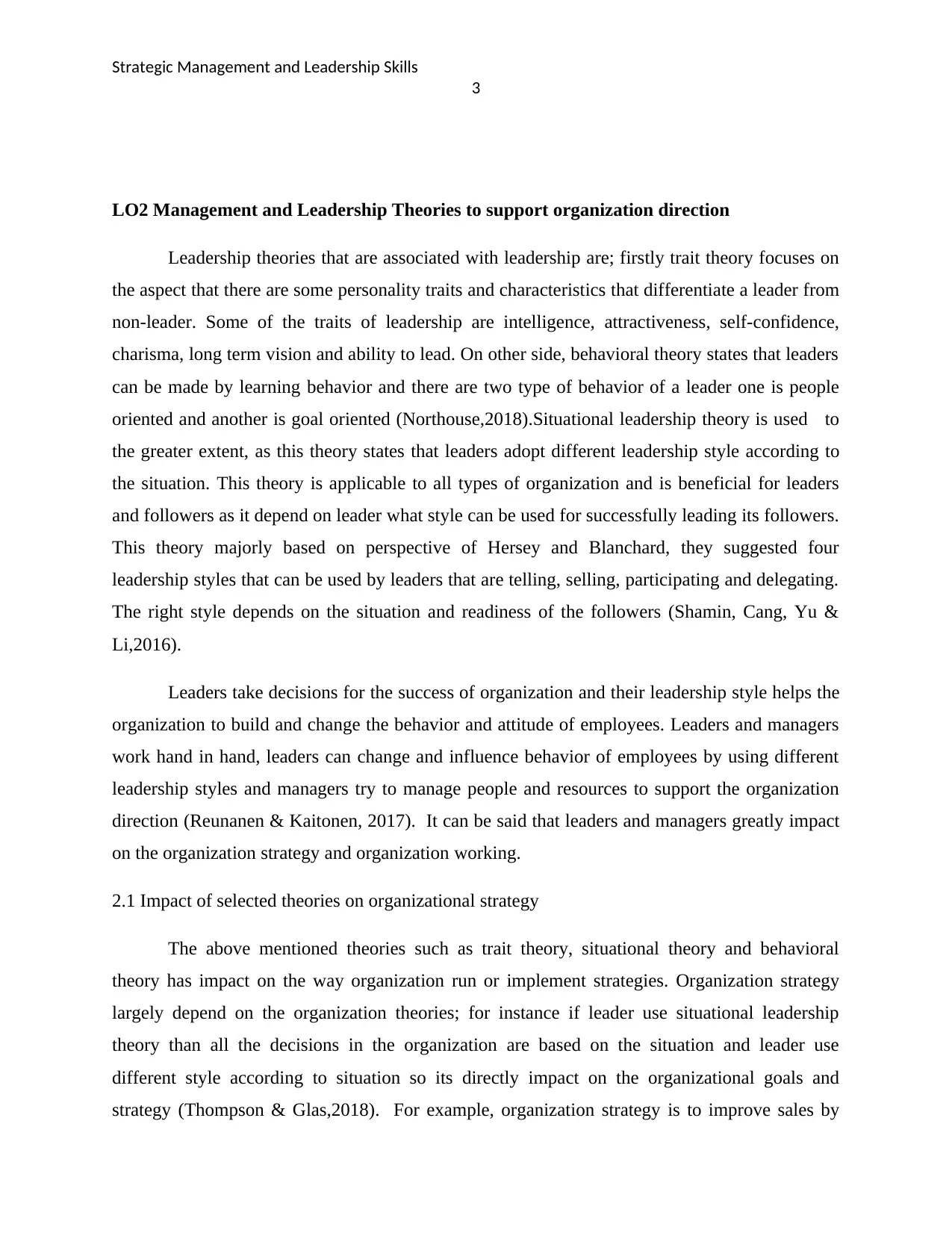
Strategic Management and Leadership Skills
3
LO2 Management and Leadership Theories to support organization direction
Leadership theories that are associated with leadership are; firstly trait theory focuses on
the aspect that there are some personality traits and characteristics that differentiate a leader from
non-leader. Some of the traits of leadership are intelligence, attractiveness, self-confidence,
charisma, long term vision and ability to lead. On other side, behavioral theory states that leaders
can be made by learning behavior and there are two type of behavior of a leader one is people
oriented and another is goal oriented (Northouse,2018).Situational leadership theory is used to
the greater extent, as this theory states that leaders adopt different leadership style according to
the situation. This theory is applicable to all types of organization and is beneficial for leaders
and followers as it depend on leader what style can be used for successfully leading its followers.
This theory majorly based on perspective of Hersey and Blanchard, they suggested four
leadership styles that can be used by leaders that are telling, selling, participating and delegating.
The right style depends on the situation and readiness of the followers (Shamin, Cang, Yu &
Li,2016).
Leaders take decisions for the success of organization and their leadership style helps the
organization to build and change the behavior and attitude of employees. Leaders and managers
work hand in hand, leaders can change and influence behavior of employees by using different
leadership styles and managers try to manage people and resources to support the organization
direction (Reunanen & Kaitonen, 2017). It can be said that leaders and managers greatly impact
on the organization strategy and organization working.
2.1 Impact of selected theories on organizational strategy
The above mentioned theories such as trait theory, situational theory and behavioral
theory has impact on the way organization run or implement strategies. Organization strategy
largely depend on the organization theories; for instance if leader use situational leadership
theory than all the decisions in the organization are based on the situation and leader use
different style according to situation so its directly impact on the organizational goals and
strategy (Thompson & Glas,2018). For example, organization strategy is to improve sales by
3
LO2 Management and Leadership Theories to support organization direction
Leadership theories that are associated with leadership are; firstly trait theory focuses on
the aspect that there are some personality traits and characteristics that differentiate a leader from
non-leader. Some of the traits of leadership are intelligence, attractiveness, self-confidence,
charisma, long term vision and ability to lead. On other side, behavioral theory states that leaders
can be made by learning behavior and there are two type of behavior of a leader one is people
oriented and another is goal oriented (Northouse,2018).Situational leadership theory is used to
the greater extent, as this theory states that leaders adopt different leadership style according to
the situation. This theory is applicable to all types of organization and is beneficial for leaders
and followers as it depend on leader what style can be used for successfully leading its followers.
This theory majorly based on perspective of Hersey and Blanchard, they suggested four
leadership styles that can be used by leaders that are telling, selling, participating and delegating.
The right style depends on the situation and readiness of the followers (Shamin, Cang, Yu &
Li,2016).
Leaders take decisions for the success of organization and their leadership style helps the
organization to build and change the behavior and attitude of employees. Leaders and managers
work hand in hand, leaders can change and influence behavior of employees by using different
leadership styles and managers try to manage people and resources to support the organization
direction (Reunanen & Kaitonen, 2017). It can be said that leaders and managers greatly impact
on the organization strategy and organization working.
2.1 Impact of selected theories on organizational strategy
The above mentioned theories such as trait theory, situational theory and behavioral
theory has impact on the way organization run or implement strategies. Organization strategy
largely depend on the organization theories; for instance if leader use situational leadership
theory than all the decisions in the organization are based on the situation and leader use
different style according to situation so its directly impact on the organizational goals and
strategy (Thompson & Glas,2018). For example, organization strategy is to improve sales by
Paraphrase This Document
Need a fresh take? Get an instant paraphrase of this document with our AI Paraphraser
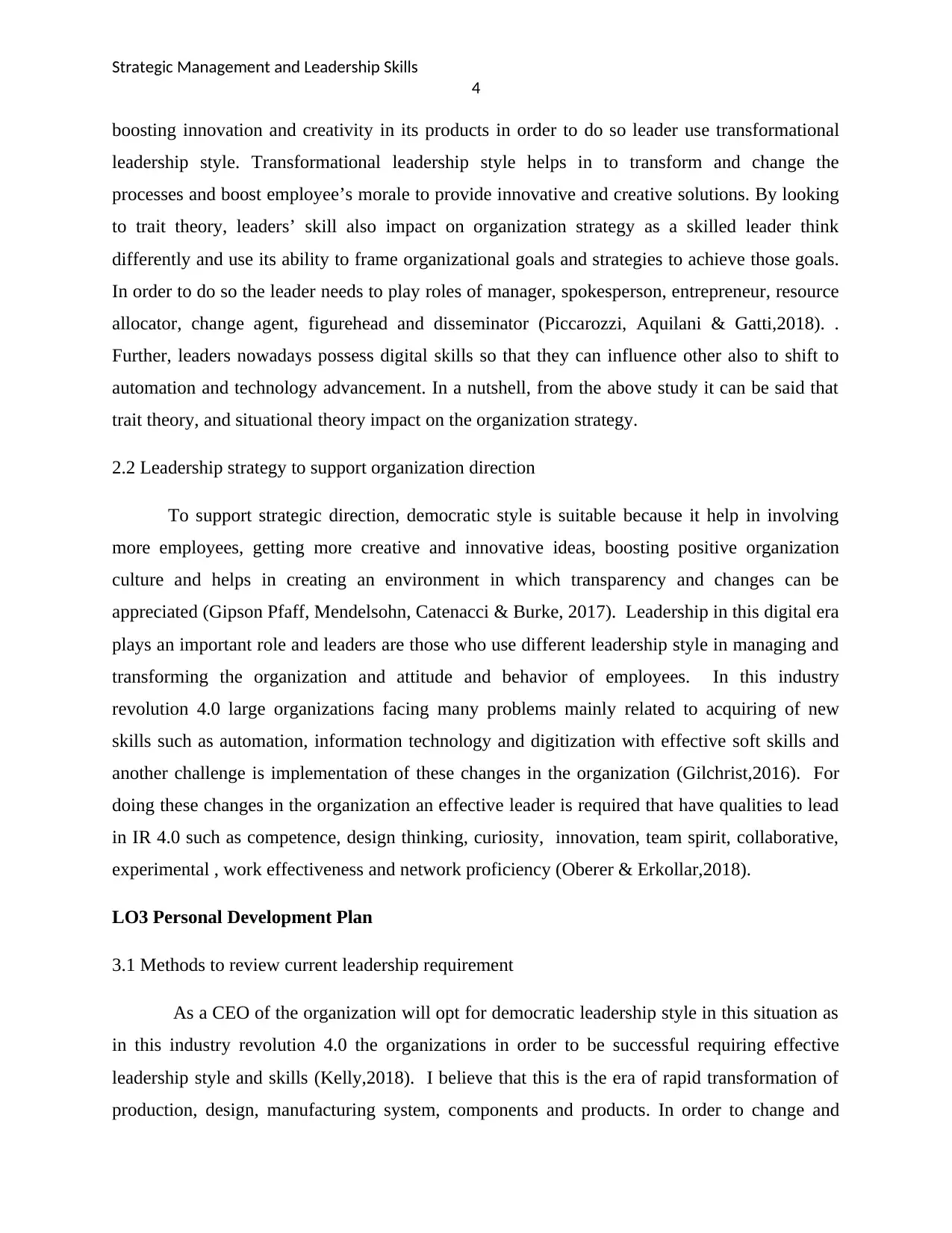
Strategic Management and Leadership Skills
4
boosting innovation and creativity in its products in order to do so leader use transformational
leadership style. Transformational leadership style helps in to transform and change the
processes and boost employee’s morale to provide innovative and creative solutions. By looking
to trait theory, leaders’ skill also impact on organization strategy as a skilled leader think
differently and use its ability to frame organizational goals and strategies to achieve those goals.
In order to do so the leader needs to play roles of manager, spokesperson, entrepreneur, resource
allocator, change agent, figurehead and disseminator (Piccarozzi, Aquilani & Gatti,2018). .
Further, leaders nowadays possess digital skills so that they can influence other also to shift to
automation and technology advancement. In a nutshell, from the above study it can be said that
trait theory, and situational theory impact on the organization strategy.
2.2 Leadership strategy to support organization direction
To support strategic direction, democratic style is suitable because it help in involving
more employees, getting more creative and innovative ideas, boosting positive organization
culture and helps in creating an environment in which transparency and changes can be
appreciated (Gipson Pfaff, Mendelsohn, Catenacci & Burke, 2017). Leadership in this digital era
plays an important role and leaders are those who use different leadership style in managing and
transforming the organization and attitude and behavior of employees. In this industry
revolution 4.0 large organizations facing many problems mainly related to acquiring of new
skills such as automation, information technology and digitization with effective soft skills and
another challenge is implementation of these changes in the organization (Gilchrist,2016). For
doing these changes in the organization an effective leader is required that have qualities to lead
in IR 4.0 such as competence, design thinking, curiosity, innovation, team spirit, collaborative,
experimental , work effectiveness and network proficiency (Oberer & Erkollar,2018).
LO3 Personal Development Plan
3.1 Methods to review current leadership requirement
As a CEO of the organization will opt for democratic leadership style in this situation as
in this industry revolution 4.0 the organizations in order to be successful requiring effective
leadership style and skills (Kelly,2018). I believe that this is the era of rapid transformation of
production, design, manufacturing system, components and products. In order to change and
4
boosting innovation and creativity in its products in order to do so leader use transformational
leadership style. Transformational leadership style helps in to transform and change the
processes and boost employee’s morale to provide innovative and creative solutions. By looking
to trait theory, leaders’ skill also impact on organization strategy as a skilled leader think
differently and use its ability to frame organizational goals and strategies to achieve those goals.
In order to do so the leader needs to play roles of manager, spokesperson, entrepreneur, resource
allocator, change agent, figurehead and disseminator (Piccarozzi, Aquilani & Gatti,2018). .
Further, leaders nowadays possess digital skills so that they can influence other also to shift to
automation and technology advancement. In a nutshell, from the above study it can be said that
trait theory, and situational theory impact on the organization strategy.
2.2 Leadership strategy to support organization direction
To support strategic direction, democratic style is suitable because it help in involving
more employees, getting more creative and innovative ideas, boosting positive organization
culture and helps in creating an environment in which transparency and changes can be
appreciated (Gipson Pfaff, Mendelsohn, Catenacci & Burke, 2017). Leadership in this digital era
plays an important role and leaders are those who use different leadership style in managing and
transforming the organization and attitude and behavior of employees. In this industry
revolution 4.0 large organizations facing many problems mainly related to acquiring of new
skills such as automation, information technology and digitization with effective soft skills and
another challenge is implementation of these changes in the organization (Gilchrist,2016). For
doing these changes in the organization an effective leader is required that have qualities to lead
in IR 4.0 such as competence, design thinking, curiosity, innovation, team spirit, collaborative,
experimental , work effectiveness and network proficiency (Oberer & Erkollar,2018).
LO3 Personal Development Plan
3.1 Methods to review current leadership requirement
As a CEO of the organization will opt for democratic leadership style in this situation as
in this industry revolution 4.0 the organizations in order to be successful requiring effective
leadership style and skills (Kelly,2018). I believe that this is the era of rapid transformation of
production, design, manufacturing system, components and products. In order to change and
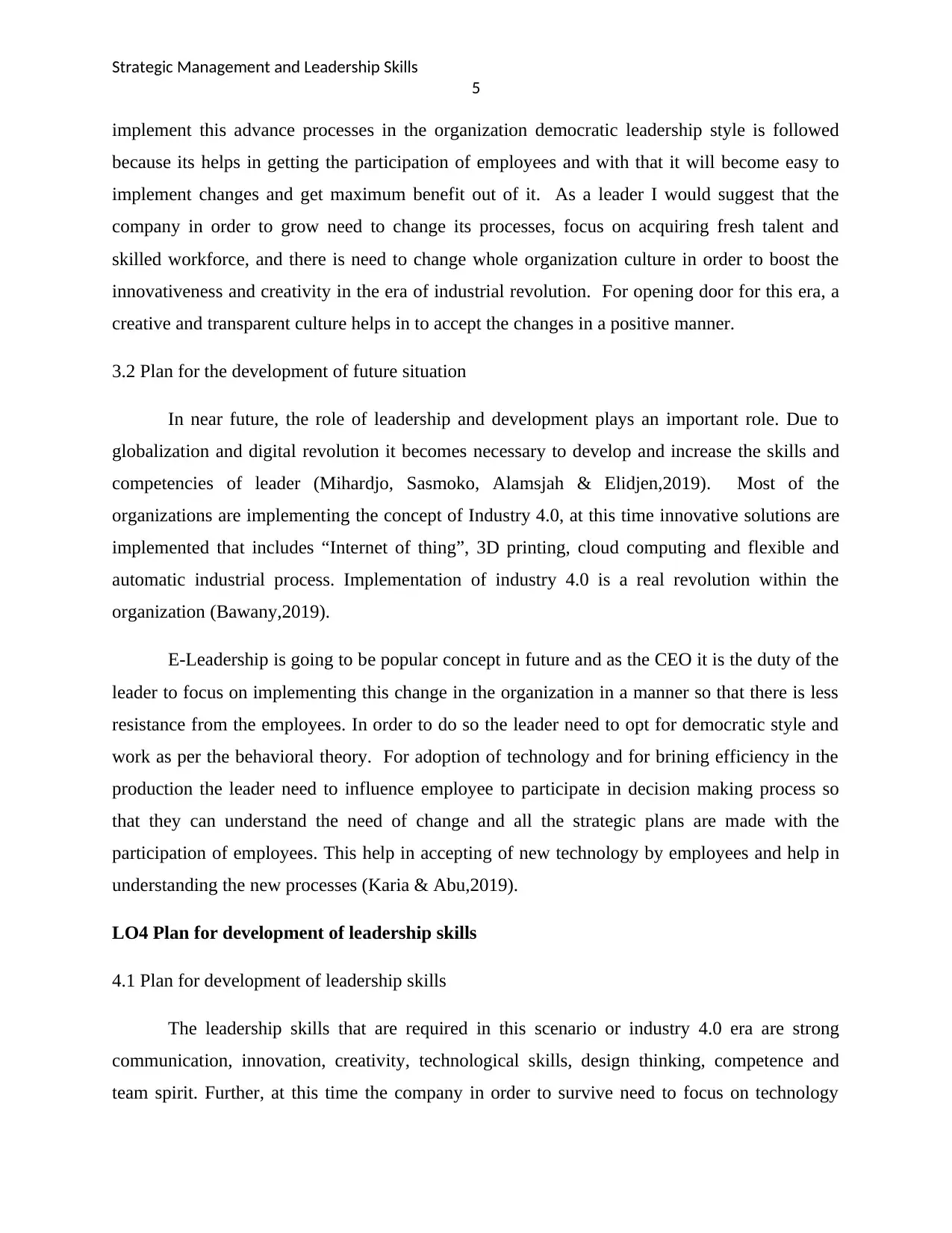
Strategic Management and Leadership Skills
5
implement this advance processes in the organization democratic leadership style is followed
because its helps in getting the participation of employees and with that it will become easy to
implement changes and get maximum benefit out of it. As a leader I would suggest that the
company in order to grow need to change its processes, focus on acquiring fresh talent and
skilled workforce, and there is need to change whole organization culture in order to boost the
innovativeness and creativity in the era of industrial revolution. For opening door for this era, a
creative and transparent culture helps in to accept the changes in a positive manner.
3.2 Plan for the development of future situation
In near future, the role of leadership and development plays an important role. Due to
globalization and digital revolution it becomes necessary to develop and increase the skills and
competencies of leader (Mihardjo, Sasmoko, Alamsjah & Elidjen,2019). Most of the
organizations are implementing the concept of Industry 4.0, at this time innovative solutions are
implemented that includes “Internet of thing”, 3D printing, cloud computing and flexible and
automatic industrial process. Implementation of industry 4.0 is a real revolution within the
organization (Bawany,2019).
E-Leadership is going to be popular concept in future and as the CEO it is the duty of the
leader to focus on implementing this change in the organization in a manner so that there is less
resistance from the employees. In order to do so the leader need to opt for democratic style and
work as per the behavioral theory. For adoption of technology and for brining efficiency in the
production the leader need to influence employee to participate in decision making process so
that they can understand the need of change and all the strategic plans are made with the
participation of employees. This help in accepting of new technology by employees and help in
understanding the new processes (Karia & Abu,2019).
LO4 Plan for development of leadership skills
4.1 Plan for development of leadership skills
The leadership skills that are required in this scenario or industry 4.0 era are strong
communication, innovation, creativity, technological skills, design thinking, competence and
team spirit. Further, at this time the company in order to survive need to focus on technology
5
implement this advance processes in the organization democratic leadership style is followed
because its helps in getting the participation of employees and with that it will become easy to
implement changes and get maximum benefit out of it. As a leader I would suggest that the
company in order to grow need to change its processes, focus on acquiring fresh talent and
skilled workforce, and there is need to change whole organization culture in order to boost the
innovativeness and creativity in the era of industrial revolution. For opening door for this era, a
creative and transparent culture helps in to accept the changes in a positive manner.
3.2 Plan for the development of future situation
In near future, the role of leadership and development plays an important role. Due to
globalization and digital revolution it becomes necessary to develop and increase the skills and
competencies of leader (Mihardjo, Sasmoko, Alamsjah & Elidjen,2019). Most of the
organizations are implementing the concept of Industry 4.0, at this time innovative solutions are
implemented that includes “Internet of thing”, 3D printing, cloud computing and flexible and
automatic industrial process. Implementation of industry 4.0 is a real revolution within the
organization (Bawany,2019).
E-Leadership is going to be popular concept in future and as the CEO it is the duty of the
leader to focus on implementing this change in the organization in a manner so that there is less
resistance from the employees. In order to do so the leader need to opt for democratic style and
work as per the behavioral theory. For adoption of technology and for brining efficiency in the
production the leader need to influence employee to participate in decision making process so
that they can understand the need of change and all the strategic plans are made with the
participation of employees. This help in accepting of new technology by employees and help in
understanding the new processes (Karia & Abu,2019).
LO4 Plan for development of leadership skills
4.1 Plan for development of leadership skills
The leadership skills that are required in this scenario or industry 4.0 era are strong
communication, innovation, creativity, technological skills, design thinking, competence and
team spirit. Further, at this time the company in order to survive need to focus on technology
⊘ This is a preview!⊘
Do you want full access?
Subscribe today to unlock all pages.

Trusted by 1+ million students worldwide
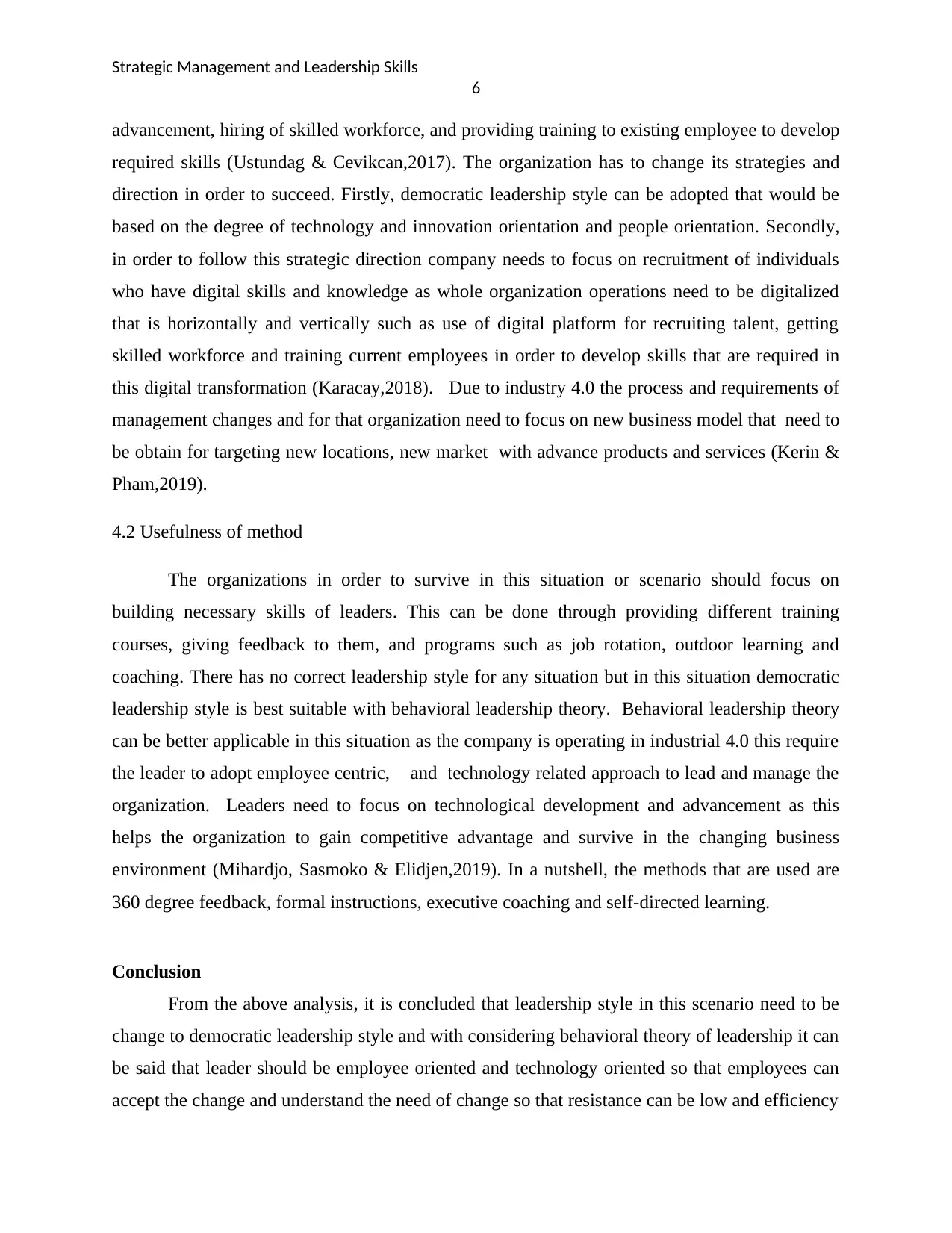
Strategic Management and Leadership Skills
6
advancement, hiring of skilled workforce, and providing training to existing employee to develop
required skills (Ustundag & Cevikcan,2017). The organization has to change its strategies and
direction in order to succeed. Firstly, democratic leadership style can be adopted that would be
based on the degree of technology and innovation orientation and people orientation. Secondly,
in order to follow this strategic direction company needs to focus on recruitment of individuals
who have digital skills and knowledge as whole organization operations need to be digitalized
that is horizontally and vertically such as use of digital platform for recruiting talent, getting
skilled workforce and training current employees in order to develop skills that are required in
this digital transformation (Karacay,2018). Due to industry 4.0 the process and requirements of
management changes and for that organization need to focus on new business model that need to
be obtain for targeting new locations, new market with advance products and services (Kerin &
Pham,2019).
4.2 Usefulness of method
The organizations in order to survive in this situation or scenario should focus on
building necessary skills of leaders. This can be done through providing different training
courses, giving feedback to them, and programs such as job rotation, outdoor learning and
coaching. There has no correct leadership style for any situation but in this situation democratic
leadership style is best suitable with behavioral leadership theory. Behavioral leadership theory
can be better applicable in this situation as the company is operating in industrial 4.0 this require
the leader to adopt employee centric, and technology related approach to lead and manage the
organization. Leaders need to focus on technological development and advancement as this
helps the organization to gain competitive advantage and survive in the changing business
environment (Mihardjo, Sasmoko & Elidjen,2019). In a nutshell, the methods that are used are
360 degree feedback, formal instructions, executive coaching and self-directed learning.
Conclusion
From the above analysis, it is concluded that leadership style in this scenario need to be
change to democratic leadership style and with considering behavioral theory of leadership it can
be said that leader should be employee oriented and technology oriented so that employees can
accept the change and understand the need of change so that resistance can be low and efficiency
6
advancement, hiring of skilled workforce, and providing training to existing employee to develop
required skills (Ustundag & Cevikcan,2017). The organization has to change its strategies and
direction in order to succeed. Firstly, democratic leadership style can be adopted that would be
based on the degree of technology and innovation orientation and people orientation. Secondly,
in order to follow this strategic direction company needs to focus on recruitment of individuals
who have digital skills and knowledge as whole organization operations need to be digitalized
that is horizontally and vertically such as use of digital platform for recruiting talent, getting
skilled workforce and training current employees in order to develop skills that are required in
this digital transformation (Karacay,2018). Due to industry 4.0 the process and requirements of
management changes and for that organization need to focus on new business model that need to
be obtain for targeting new locations, new market with advance products and services (Kerin &
Pham,2019).
4.2 Usefulness of method
The organizations in order to survive in this situation or scenario should focus on
building necessary skills of leaders. This can be done through providing different training
courses, giving feedback to them, and programs such as job rotation, outdoor learning and
coaching. There has no correct leadership style for any situation but in this situation democratic
leadership style is best suitable with behavioral leadership theory. Behavioral leadership theory
can be better applicable in this situation as the company is operating in industrial 4.0 this require
the leader to adopt employee centric, and technology related approach to lead and manage the
organization. Leaders need to focus on technological development and advancement as this
helps the organization to gain competitive advantage and survive in the changing business
environment (Mihardjo, Sasmoko & Elidjen,2019). In a nutshell, the methods that are used are
360 degree feedback, formal instructions, executive coaching and self-directed learning.
Conclusion
From the above analysis, it is concluded that leadership style in this scenario need to be
change to democratic leadership style and with considering behavioral theory of leadership it can
be said that leader should be employee oriented and technology oriented so that employees can
accept the change and understand the need of change so that resistance can be low and efficiency
Paraphrase This Document
Need a fresh take? Get an instant paraphrase of this document with our AI Paraphraser
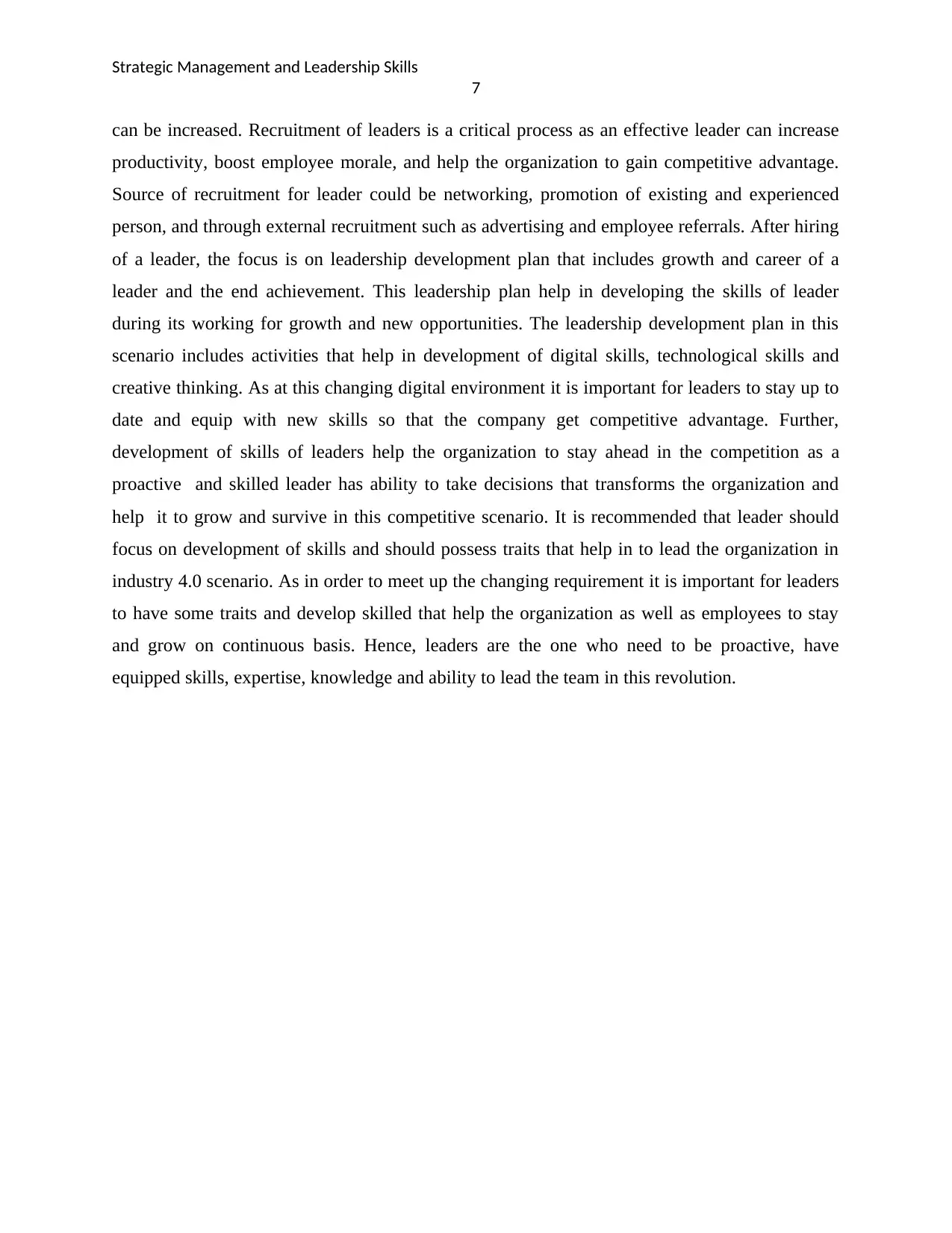
Strategic Management and Leadership Skills
7
can be increased. Recruitment of leaders is a critical process as an effective leader can increase
productivity, boost employee morale, and help the organization to gain competitive advantage.
Source of recruitment for leader could be networking, promotion of existing and experienced
person, and through external recruitment such as advertising and employee referrals. After hiring
of a leader, the focus is on leadership development plan that includes growth and career of a
leader and the end achievement. This leadership plan help in developing the skills of leader
during its working for growth and new opportunities. The leadership development plan in this
scenario includes activities that help in development of digital skills, technological skills and
creative thinking. As at this changing digital environment it is important for leaders to stay up to
date and equip with new skills so that the company get competitive advantage. Further,
development of skills of leaders help the organization to stay ahead in the competition as a
proactive and skilled leader has ability to take decisions that transforms the organization and
help it to grow and survive in this competitive scenario. It is recommended that leader should
focus on development of skills and should possess traits that help in to lead the organization in
industry 4.0 scenario. As in order to meet up the changing requirement it is important for leaders
to have some traits and develop skilled that help the organization as well as employees to stay
and grow on continuous basis. Hence, leaders are the one who need to be proactive, have
equipped skills, expertise, knowledge and ability to lead the team in this revolution.
7
can be increased. Recruitment of leaders is a critical process as an effective leader can increase
productivity, boost employee morale, and help the organization to gain competitive advantage.
Source of recruitment for leader could be networking, promotion of existing and experienced
person, and through external recruitment such as advertising and employee referrals. After hiring
of a leader, the focus is on leadership development plan that includes growth and career of a
leader and the end achievement. This leadership plan help in developing the skills of leader
during its working for growth and new opportunities. The leadership development plan in this
scenario includes activities that help in development of digital skills, technological skills and
creative thinking. As at this changing digital environment it is important for leaders to stay up to
date and equip with new skills so that the company get competitive advantage. Further,
development of skills of leaders help the organization to stay ahead in the competition as a
proactive and skilled leader has ability to take decisions that transforms the organization and
help it to grow and survive in this competitive scenario. It is recommended that leader should
focus on development of skills and should possess traits that help in to lead the organization in
industry 4.0 scenario. As in order to meet up the changing requirement it is important for leaders
to have some traits and develop skilled that help the organization as well as employees to stay
and grow on continuous basis. Hence, leaders are the one who need to be proactive, have
equipped skills, expertise, knowledge and ability to lead the team in this revolution.
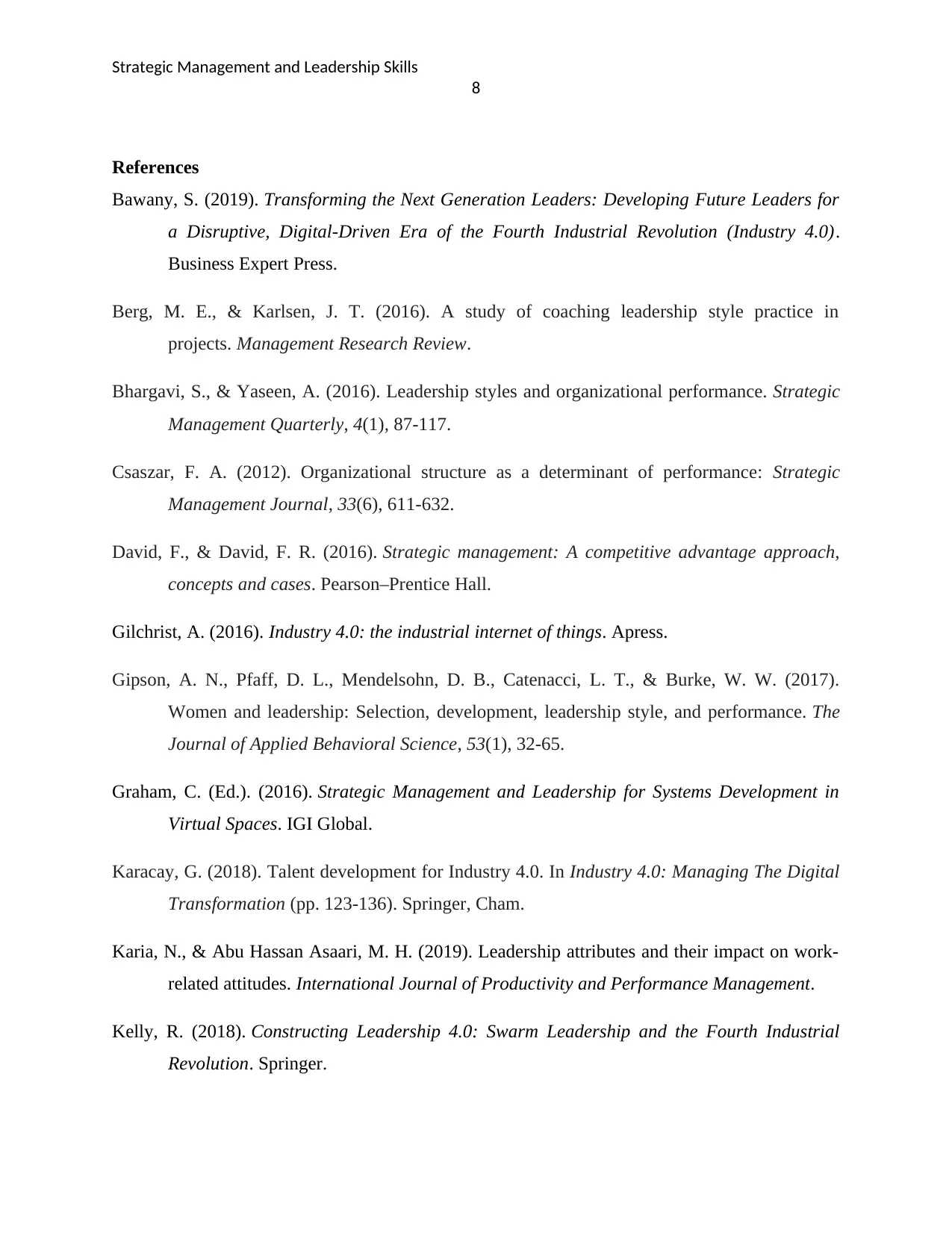
Strategic Management and Leadership Skills
8
References
Bawany, S. (2019). Transforming the Next Generation Leaders: Developing Future Leaders for
a Disruptive, Digital-Driven Era of the Fourth Industrial Revolution (Industry 4.0).
Business Expert Press.
Berg, M. E., & Karlsen, J. T. (2016). A study of coaching leadership style practice in
projects. Management Research Review.
Bhargavi, S., & Yaseen, A. (2016). Leadership styles and organizational performance. Strategic
Management Quarterly, 4(1), 87-117.
Csaszar, F. A. (2012). Organizational structure as a determinant of performance: Strategic
Management Journal, 33(6), 611-632.
David, F., & David, F. R. (2016). Strategic management: A competitive advantage approach,
concepts and cases. Pearson–Prentice Hall.
Gilchrist, A. (2016). Industry 4.0: the industrial internet of things. Apress.
Gipson, A. N., Pfaff, D. L., Mendelsohn, D. B., Catenacci, L. T., & Burke, W. W. (2017).
Women and leadership: Selection, development, leadership style, and performance. The
Journal of Applied Behavioral Science, 53(1), 32-65.
Graham, C. (Ed.). (2016). Strategic Management and Leadership for Systems Development in
Virtual Spaces. IGI Global.
Karacay, G. (2018). Talent development for Industry 4.0. In Industry 4.0: Managing The Digital
Transformation (pp. 123-136). Springer, Cham.
Karia, N., & Abu Hassan Asaari, M. H. (2019). Leadership attributes and their impact on work-
related attitudes. International Journal of Productivity and Performance Management.
Kelly, R. (2018). Constructing Leadership 4.0: Swarm Leadership and the Fourth Industrial
Revolution. Springer.
8
References
Bawany, S. (2019). Transforming the Next Generation Leaders: Developing Future Leaders for
a Disruptive, Digital-Driven Era of the Fourth Industrial Revolution (Industry 4.0).
Business Expert Press.
Berg, M. E., & Karlsen, J. T. (2016). A study of coaching leadership style practice in
projects. Management Research Review.
Bhargavi, S., & Yaseen, A. (2016). Leadership styles and organizational performance. Strategic
Management Quarterly, 4(1), 87-117.
Csaszar, F. A. (2012). Organizational structure as a determinant of performance: Strategic
Management Journal, 33(6), 611-632.
David, F., & David, F. R. (2016). Strategic management: A competitive advantage approach,
concepts and cases. Pearson–Prentice Hall.
Gilchrist, A. (2016). Industry 4.0: the industrial internet of things. Apress.
Gipson, A. N., Pfaff, D. L., Mendelsohn, D. B., Catenacci, L. T., & Burke, W. W. (2017).
Women and leadership: Selection, development, leadership style, and performance. The
Journal of Applied Behavioral Science, 53(1), 32-65.
Graham, C. (Ed.). (2016). Strategic Management and Leadership for Systems Development in
Virtual Spaces. IGI Global.
Karacay, G. (2018). Talent development for Industry 4.0. In Industry 4.0: Managing The Digital
Transformation (pp. 123-136). Springer, Cham.
Karia, N., & Abu Hassan Asaari, M. H. (2019). Leadership attributes and their impact on work-
related attitudes. International Journal of Productivity and Performance Management.
Kelly, R. (2018). Constructing Leadership 4.0: Swarm Leadership and the Fourth Industrial
Revolution. Springer.
⊘ This is a preview!⊘
Do you want full access?
Subscribe today to unlock all pages.

Trusted by 1+ million students worldwide
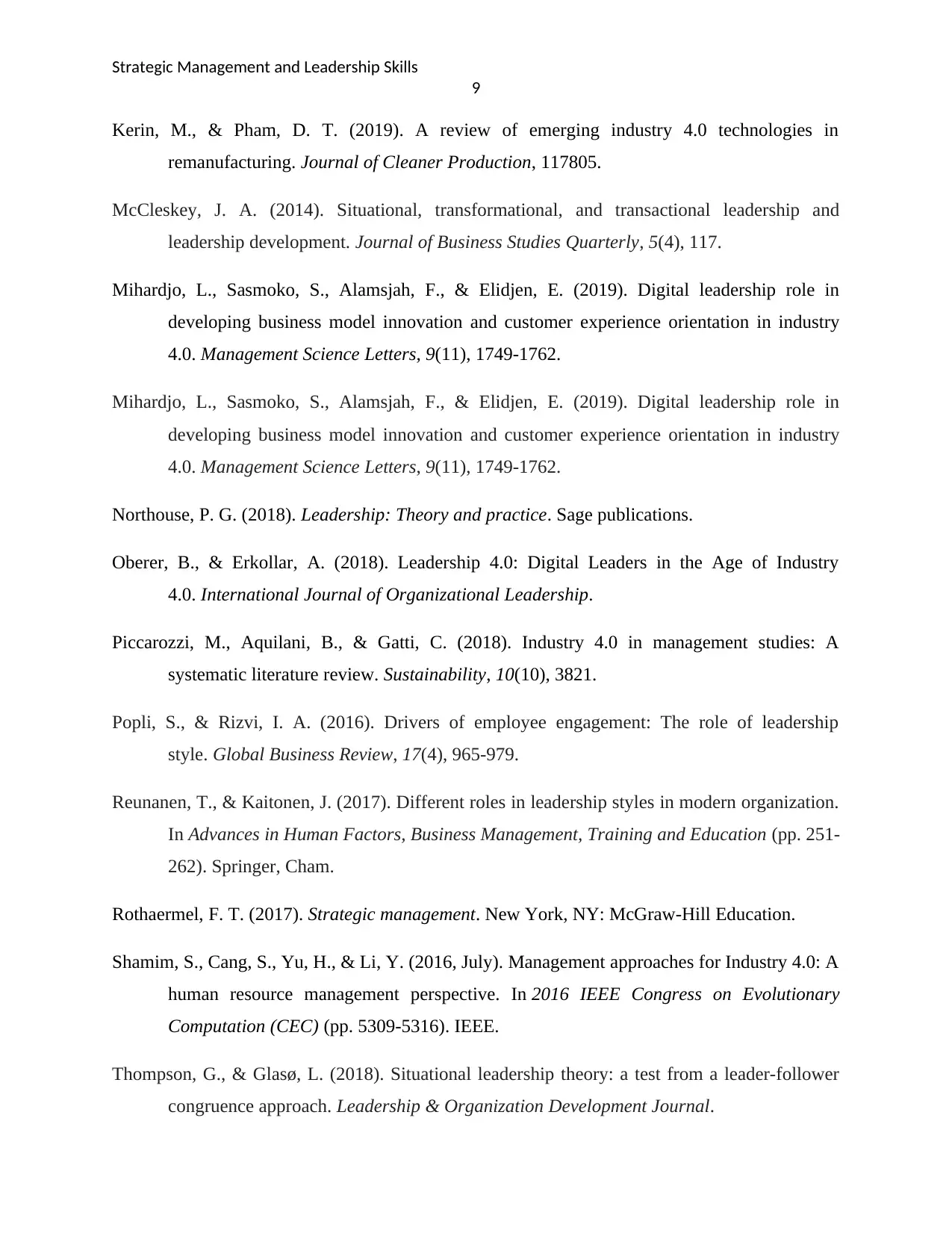
Strategic Management and Leadership Skills
9
Kerin, M., & Pham, D. T. (2019). A review of emerging industry 4.0 technologies in
remanufacturing. Journal of Cleaner Production, 117805.
McCleskey, J. A. (2014). Situational, transformational, and transactional leadership and
leadership development. Journal of Business Studies Quarterly, 5(4), 117.
Mihardjo, L., Sasmoko, S., Alamsjah, F., & Elidjen, E. (2019). Digital leadership role in
developing business model innovation and customer experience orientation in industry
4.0. Management Science Letters, 9(11), 1749-1762.
Mihardjo, L., Sasmoko, S., Alamsjah, F., & Elidjen, E. (2019). Digital leadership role in
developing business model innovation and customer experience orientation in industry
4.0. Management Science Letters, 9(11), 1749-1762.
Northouse, P. G. (2018). Leadership: Theory and practice. Sage publications.
Oberer, B., & Erkollar, A. (2018). Leadership 4.0: Digital Leaders in the Age of Industry
4.0. International Journal of Organizational Leadership.
Piccarozzi, M., Aquilani, B., & Gatti, C. (2018). Industry 4.0 in management studies: A
systematic literature review. Sustainability, 10(10), 3821.
Popli, S., & Rizvi, I. A. (2016). Drivers of employee engagement: The role of leadership
style. Global Business Review, 17(4), 965-979.
Reunanen, T., & Kaitonen, J. (2017). Different roles in leadership styles in modern organization.
In Advances in Human Factors, Business Management, Training and Education (pp. 251-
262). Springer, Cham.
Rothaermel, F. T. (2017). Strategic management. New York, NY: McGraw-Hill Education.
Shamim, S., Cang, S., Yu, H., & Li, Y. (2016, July). Management approaches for Industry 4.0: A
human resource management perspective. In 2016 IEEE Congress on Evolutionary
Computation (CEC) (pp. 5309-5316). IEEE.
Thompson, G., & Glasø, L. (2018). Situational leadership theory: a test from a leader-follower
congruence approach. Leadership & Organization Development Journal.
9
Kerin, M., & Pham, D. T. (2019). A review of emerging industry 4.0 technologies in
remanufacturing. Journal of Cleaner Production, 117805.
McCleskey, J. A. (2014). Situational, transformational, and transactional leadership and
leadership development. Journal of Business Studies Quarterly, 5(4), 117.
Mihardjo, L., Sasmoko, S., Alamsjah, F., & Elidjen, E. (2019). Digital leadership role in
developing business model innovation and customer experience orientation in industry
4.0. Management Science Letters, 9(11), 1749-1762.
Mihardjo, L., Sasmoko, S., Alamsjah, F., & Elidjen, E. (2019). Digital leadership role in
developing business model innovation and customer experience orientation in industry
4.0. Management Science Letters, 9(11), 1749-1762.
Northouse, P. G. (2018). Leadership: Theory and practice. Sage publications.
Oberer, B., & Erkollar, A. (2018). Leadership 4.0: Digital Leaders in the Age of Industry
4.0. International Journal of Organizational Leadership.
Piccarozzi, M., Aquilani, B., & Gatti, C. (2018). Industry 4.0 in management studies: A
systematic literature review. Sustainability, 10(10), 3821.
Popli, S., & Rizvi, I. A. (2016). Drivers of employee engagement: The role of leadership
style. Global Business Review, 17(4), 965-979.
Reunanen, T., & Kaitonen, J. (2017). Different roles in leadership styles in modern organization.
In Advances in Human Factors, Business Management, Training and Education (pp. 251-
262). Springer, Cham.
Rothaermel, F. T. (2017). Strategic management. New York, NY: McGraw-Hill Education.
Shamim, S., Cang, S., Yu, H., & Li, Y. (2016, July). Management approaches for Industry 4.0: A
human resource management perspective. In 2016 IEEE Congress on Evolutionary
Computation (CEC) (pp. 5309-5316). IEEE.
Thompson, G., & Glasø, L. (2018). Situational leadership theory: a test from a leader-follower
congruence approach. Leadership & Organization Development Journal.
Paraphrase This Document
Need a fresh take? Get an instant paraphrase of this document with our AI Paraphraser
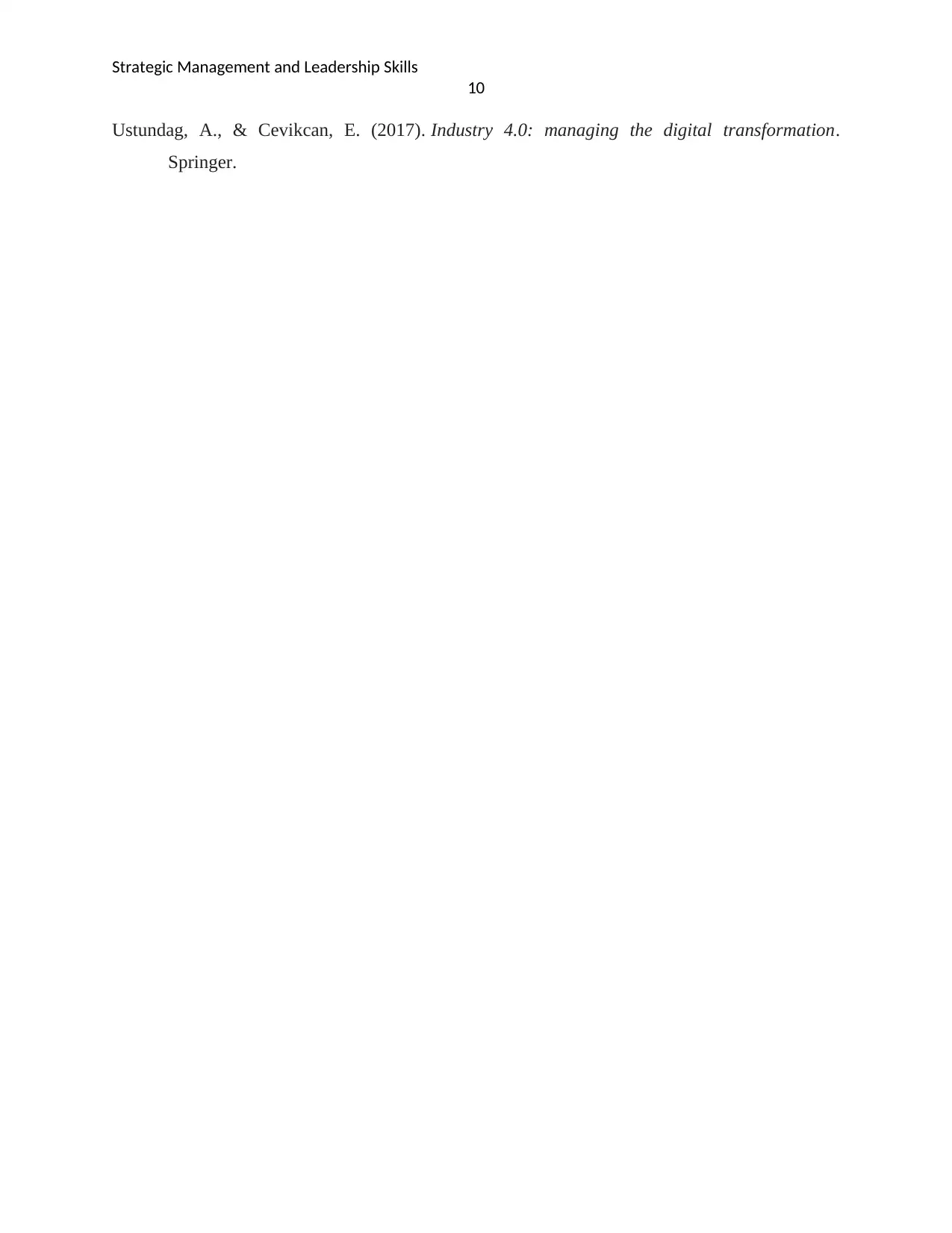
Strategic Management and Leadership Skills
10
Ustundag, A., & Cevikcan, E. (2017). Industry 4.0: managing the digital transformation.
Springer.
10
Ustundag, A., & Cevikcan, E. (2017). Industry 4.0: managing the digital transformation.
Springer.
1 out of 11
Related Documents
Your All-in-One AI-Powered Toolkit for Academic Success.
+13062052269
info@desklib.com
Available 24*7 on WhatsApp / Email
![[object Object]](/_next/static/media/star-bottom.7253800d.svg)
Unlock your academic potential
Copyright © 2020–2025 A2Z Services. All Rights Reserved. Developed and managed by ZUCOL.




